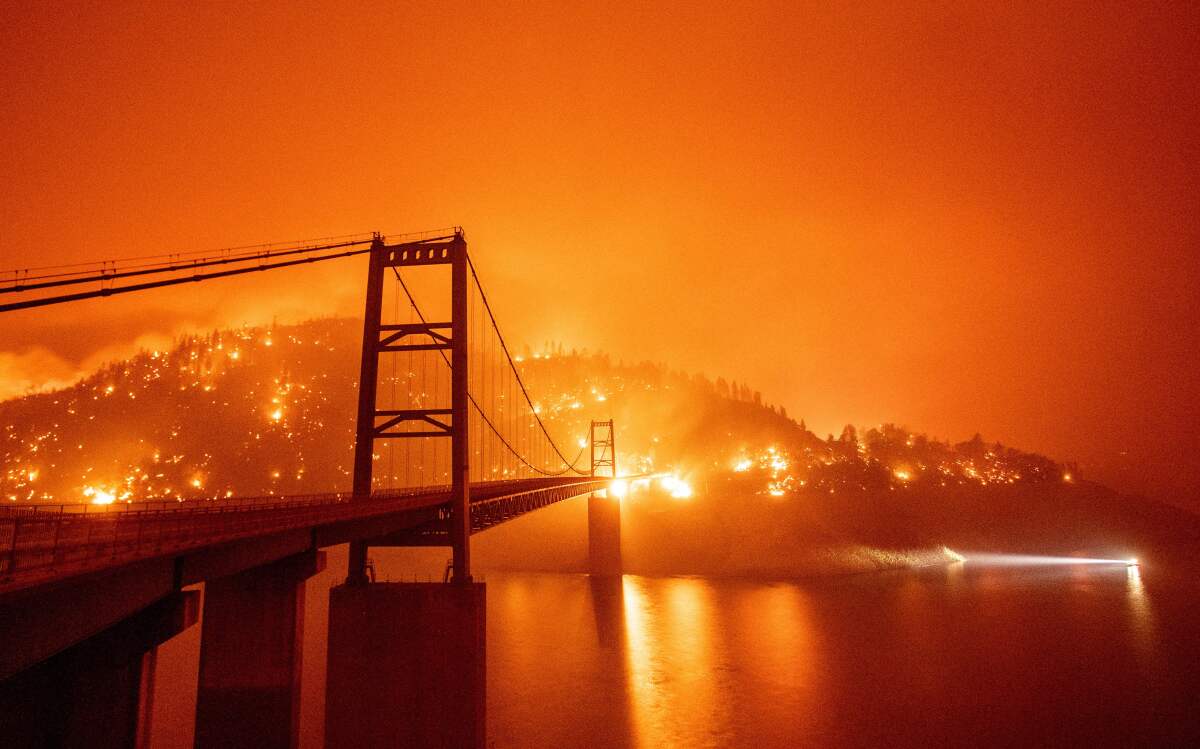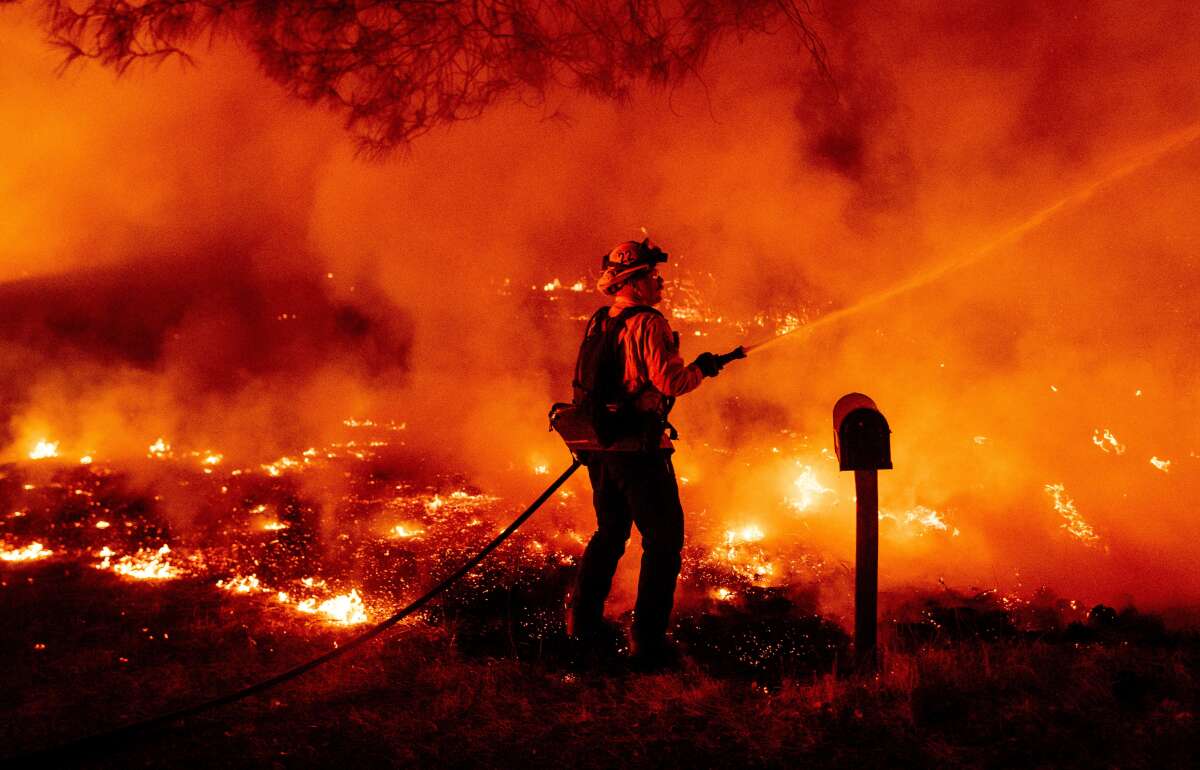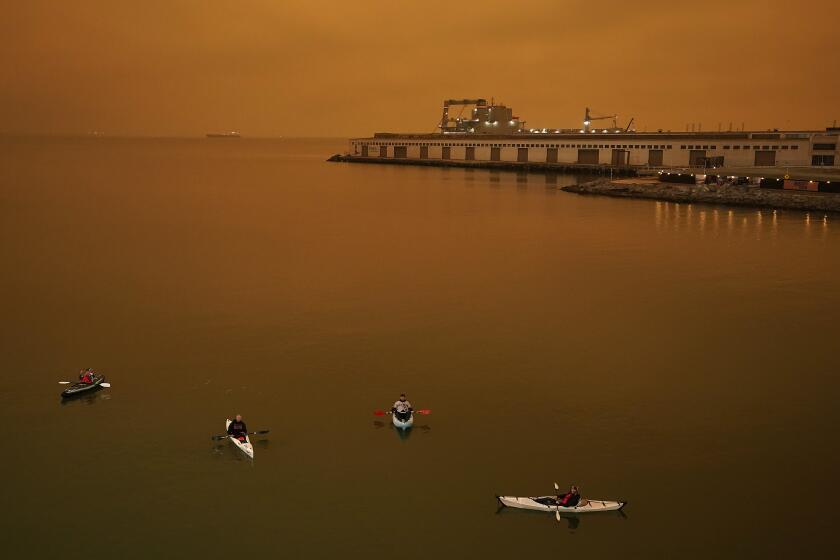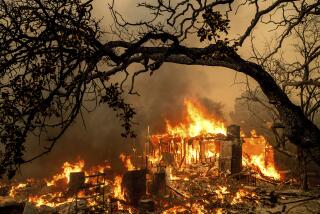If California wants to know how to cope with the apocalypse, ask Butte County

- Share via
When Laura Cootsona woke up on Wednesday morning and learned that the North Complex fire was ravaging Butte County, she immediately thought about the horrors of the Camp fire.
Outside, the sky was dark as night and ash was raining down — the same way it was two years ago when thousands of people were forced to flee the flames engulfing their mountain homes. Entire towns, including Paradise, were destroyed and 85 people died, making it the deadliest fire in California’s history.
“The PTSD from the smoke smell is real,” Cootsona told me from her office in Chico, as the North Complex blaze swelled to more than 250,000 acres and barreled toward Oroville. “It’s horrible.”

The North Complex, which includes the Bear fire, is now the 10th-largest wildfire in state history, according to the California Department of Forestry and Fire Protection. By Wednesday evening, word had spread that the town of Berry Creek was gone. Three people had been reported dead and several more were missing. By Thursday evening, the death toll had increased to 10.
All told, wildfires have burned more than 3.1 million acres across California this year — the most on record.
Given that the apocalypse is clearly upon us, orange skies and all, one would expect that such devastation would break a community’s spirit. Instead, there’s a sort of resigned resilience in rural Butte County, which like Sonoma, Napa and Lake counties has been pounded by disaster after disaster in recent years.
And there’s also a decent amount of indignant anger, much of it directed at state and federal agencies for not doing more controlled burns to prevent or slow wildfires. “It’s frustrating to me at 67 years of age to see it go from when it was managed and the fires were much smaller to what they are today,” said Butte County Supervisor Bill Connelly.
When conflagrations do inevitably explode in the mountainous terrain, like the Wall and Ponderosa fires did in 2017, there’s a well-worn routine to reacting to it all.
“Unfortunately, we’re well versed in evacuating,” Oroville Mayor Chuck Reynolds said Wednesday. “We have a lot of experience in that area now, and everyone seems to have their things in order to know what they would take and what they have ready to take. There doesn’t seem to be near the amount of panic.”

Many in Butte County trace this back to one Sunday afternoon in early 2017 when, fearing that a spillway on the Oroville Dam was in danger of collapse, Sheriff-Coroner Kory Honea ordered the immediate mass evacuation of nearly 190,000 residents in communities downstream along the Feather River.
For hours, panicked and frustrated drivers sat in bumper-to-bumper traffic trying to escape.
This was before the Camp fire devastated the town of Paradise and before the Woolsey fire, which burned 151 square miles from Westlake Village to Malibu — an area roughly a third the size of the city of Los Angeles. It also was before the Tubbs fire, which burned swaths of Napa, Sonoma and Lake counties, devastating Santa Rosa.
“We joke that it was our training wheels for a fire,” Cootsona said.
The skies around the Bay Area and other parts of Northern California took on an eerie glow as smoke from several fires enveloped the region.
I distinctly remember that Sunday afternoon in 2017. I was sitting on a patio, some 70 miles away in Sacramento, when a woman at the next table suddenly jumped to her feet and started screaming into her cellphone.
She was frantic, almost crying, telling whoever was on the other end of the line that she had just gotten an alert about the evacuation, was on a day trip and needed to warn her kids about the evacuation and somehow get her horses to safety.
It’s the kind of panic that has become more common in recent years as wildfires have become megafires, leading to mass evacuations on extremely short notice. Butte County is going through it yet again this week with the North Complex.
And now, of course, there’s COVID-19 to consider. Cootsona, who is executive director of the Jesus Center homeless services agency in Chico, is among those trying to figure out how to manage the fires in the middle of a pandemic.

The biggest challenge? What to do with the many people fleeing down the mountain. Or the many people who lost their homes in the Camp fire two years ago and are still living in RVs and tents.
To reduce the risk of spreading the coronavirus, Butte County isn’t using congregate shelters for evacuees. That has left hotels and motels as the next best choice. And indeed, as of Wednesday, some 90 families have been placed in rooms around Butte County.
But another 140 families are waiting. One big reason for that is because homeless people are already occupying many of the rooms under Project Roomkey, a months-old state initiative aimed at slowing the spread of COVID-19 by getting the most vulnerable people off the streets and into hotels and motels.
Then there are the complications for emergency personnel, from firefighters on down to the agencies like the Jesus Center that provide other services.
Cootsona offered up one anecdote about an employee who lives in Paradise. “Her house survived the fire,” Cootsona told me. “The fire came through her neighborhood twice and she had to move out for five months because of the smoke damage, but she moved back.”
Then, COVID-19 hit. Because of the pandemic, her children had been taking classes from home. Then, this week, Pacific Gas & Electric started shutting off the power to avoid igniting a fire during red flag conditions. With no electricity and no internet service, the employee had to drive down the mountain to access a WiFi hotspot so her children could finish the school day.
Then, the North Complex fire started to move in. Now she’s back at her grandmother’s house, trying to coordinate how to distribute 600 meals per day to people in need.
“Of course, the only indispensable person in the building had to evacuate,” Cootsona said.
But that’s just life in Butte County.
Meanwhile, the North Complex fire continues to burn — one of about 7,700 wildfires that have charred the state this year. I can’t help but wonder if it’s a glimpse into how all Californians will one day have to live with an increasingly apocalyptic future fueled by climate change.
“I’ve been in office 16 years,” Connelly said. “I’ve had six fires in six years, none of which has been as big as the Camp fire — until this one.”
More to Read
Sign up for Essential California
The most important California stories and recommendations in your inbox every morning.
You may occasionally receive promotional content from the Los Angeles Times.















